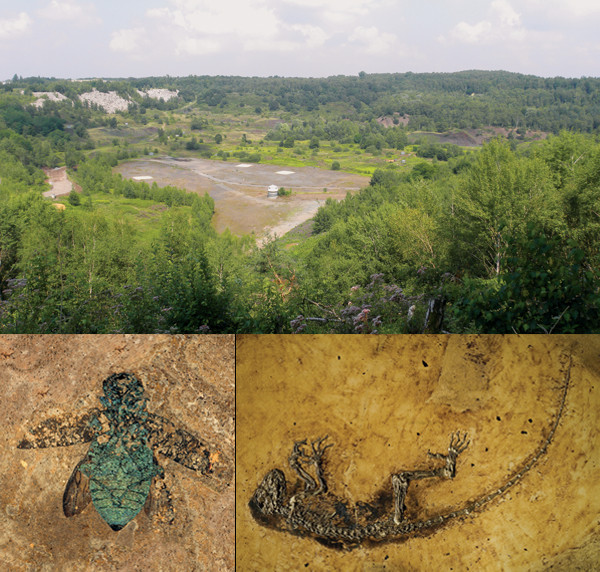
by Mary Caperton Morton Thursday, July 10, 2014

Hundreds of thousands of fossils — many in such fine detail that soft tissues and gut contents are visible to the naked eye — have been recovered from the Messel site in Germany. Credit: clockwise from top: Mark A. Wilson; ©Franzen et al., PLOS ONE, 2009; ©Gerbil, CC BY-SA 3.0.
Located in a former shale quarry near Frankfurt, Germany, the Messel deposit is so fossil-rich it has been named a UNESCO World Heritage Site. About 48 million years ago, this area was a forest surrounding a lake. Scientists hypothesize that a sudden release of toxic gases from the lake — similar to that at Cameroon’s Lake Nyos in August 1986 — smothered thousands of organisms, many of which sank to the bottom of the oxygen-poor lake, where they were fossilized in such fine detail that soft tissues and gut contents are visible to the naked eye.
“The Messel is a very special fossil assemblage,” says Jennifer Dunne, an ecologist at the Santa Fe Institute in New Mexico and lead author of the new study, published in the Proceedings of the Royal Society B: Biological Sciences. “It preserves outstanding evidence of feeding interactions, including stomach contents and bite marks in soft tissues that can be traced back to particular species’ mouth parts.”
To reconstruct a food web for the Messel assemblage, Dunne and colleagues sifted through decades of published research and compiled more than 6,500 feeding interactions among more than 700 species of plants, insects and animals. “Compiling data was really an arduous task,” says co-author Conrad Labandeira of the Smithsonian National Museum of Natural History in Washington, D.C. “We combed through papers on plants, microfossils, insects and vertebrates going back to the 1940s.”
To compare the 48-million-year-old web with modern webs, which are traditionally grouped by habitat, the team organized their data into two networks of feeding interactions — one for the lake and one for the surrounding forest. Statistical analysis revealed that, compared to today’s food webs, the Messel food webs contained similar fractions of cannibals, herbivores and carnivores, and similar distributions of generalist and specialist feeders. In addition, the approximate mean lengths of feeding chains connecting pairs of taxa were similar to today’s food webs — “despite the fact that 48 million years of species turnover and evolution separate the Messel ecosystem from modern ecosystems,” Dunne says.
The similarity isn’t surprising, says Peter Roopnarine, an evolutionary ecologist at the California Academy of Sciences in San Francisco who was not involved with the new research. “The actors may change over time, but we’ve found that the patterns of interactions tend to remain constant.” The web does shed some light on how quickly ecosystems recover from mass extinctions, he says. The Messel organisms were thriving less than 18 million years after the end-Cretaceous mass extinction that killed off the dinosaurs, along with three-quarters of all plant and animal species.
“Mass extinctions bring dramatic changes to ecosystems, but we’ve found that richness rebounds very quickly,” Roopnarine says. “We’d love to know more about how this ecosystem went from the aftermath of a massive extinction to this point: Did it take 18 million years, or was it fairly quick?” Unfortunately, finding other well-preserved assemblages in between the end-Cretaceous event and the Messel is unlikely. “We’re going to have to find ways to fill in the gaps without relying on this kind of reconstruction.”
Another potential implication of the new research, Roopnarine says, is that the Messel web may provide some information about how modern food webs might react to climate change and habitat destruction. Most modern food webs are less detailed than the Messel food webs, simply due to the complexity of interactions and a lack of interest in piecing together whole ecosystems, he says. “There are only a handful of modern food webs out there that run into the hundreds of species. We need more people doing this kind of work.”
© 2008-2021. All rights reserved. Any copying, redistribution or retransmission of any of the contents of this service without the expressed written permission of the American Geosciences Institute is expressly prohibited. Click here for all copyright requests.